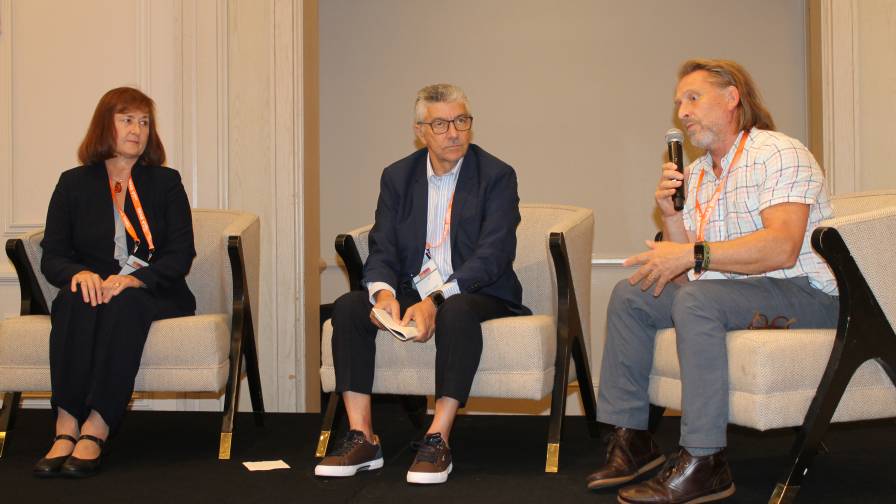Trade Summit: Mending the Great Biological/Chemical Divide

From left: The panel for the session “Mending the Great Biological/Chemical Divide” included Mariola Kopcinski, Global Business Manager AgroChemicals, Ingevity; Pedro Juan, Head of Food Chain Management, Certis Belchim; and Stephen Pearce, Co-Founder and Managing Partner, Chemovateq Swiss AG Investments.
If there’s one topic folks in the agricultural industry have talked about globally over the past decade or so, it’s biologicals. In terms of pure market numbers, the amount of research activity and financial investment being made into this sector of the ag business has never been greater.
Yet, market acceptance for these products has tended to lag somewhat, particularly in some segments of agriculture. This has been especially true in the row crop category, where the market penetration of biologicals has been less than stellar. In fact, according to a 2023 survey of ag retailers by AgriBusiness Global’s sister publication, CropLife magazine, biologicals such as biofertilizers and biostimulants are growing somewhat. Based on the survey data, biofertilizers have increased their market share among row crop growers from 30% in 2018 to 50% in 2023. Likewise, biostimulants usage has grown from 60% to 73% over this same timeframe. However, for biopesticides, the usage rates have dropped, from 31% in 2018 to just 19% in 2023.
Then of course, there’s the market perception that biologicals and synthetic chemistries don’t play well together. “There’s still a belief that biologicals are not conforming to the requirements of regular chemistries,” said Mariola Kopcinski, Global Business Manager, AgroChemicals at Ingevity, speaking at the 2023 AgriBusiness Global Trade Summit in August. “This is because most biologicals are preventatives and dependent upon field conditions. Also, because biologicals tend to help plants get stronger or grow and are not killing pests.” In addition, Kopcinski pointed to such factors as shorter shelf lives for biologicals (most being ineffective after two to three months in storage) and an inability to tank mix with synthetics when being sprayed in crop fields.
According to Stephen Pearce, Co-Founder and Managing Partner at Chemovateq Swiss AG Investments, another reason for this lack of penetration in row crops ties back to scaling. “Right now, biologicals are largely deployed in high value crops,” said Pearce. “Part of that is the difficulty experienced in the scaling of the products. Until this side of manufacturing them improves, it will remain a challenge for biologicals to gain traction in row crops.”
Still, there are market positives in view. According to Pedro Juan, Head of Food Chain Management at Certis Belchim, certain European markets are embracing biologicals. And according to Ingevity’s Kopcinski, biologicals are being used regularly by grower in Brazil as part of their seed treatment practices.
Then of course, there’s the increased investment in biologicals by major agrochemical manufacturers. “Syngenta has announced that it will have 1,200 people working in biologicals, which seems amazing,” she said. “Corteva, BASF, Bayer, FMC . . . basically, everyone is also investing heavily in them.”

Mariola Kopcinski, Ingevity
However, this could cause some problems for biologicals given how many of the most popular brands made it to market in the first place. “Many of the formulations of biologicals today are coming from larger pesticide companies,” said Kopcinski. “But the discoveries are made by the smaller companies – ones started by scientists that no longer have the numbers needed to specialize in new market development.”
Chemovateq Swiss AG Investments’ Pearce agrees. “Small company funding has dried up and many of these companies are trying hard to raise more money,” he said. “In recent years, there was $3.8 billion invested in small biological companies. But 75% of that ended up in bankrupt assets. That’s not a good number.”






